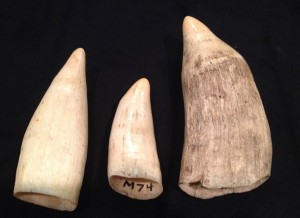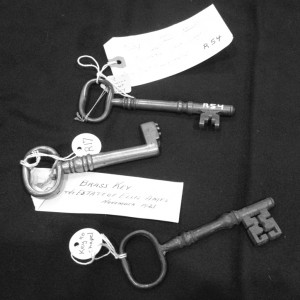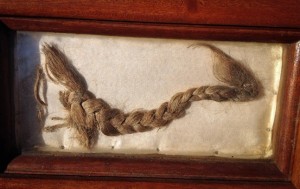True Tales from Canton’s Past: The Bears Arrive
By George T. ComeauThe following is an excerpt from “The Bears Arrive,” the latest installment of True Tales by local historian George T. Comeau
Bear Pack 77 descended like a pack of small cubs. They tumbled and played on the front lawn of the Canton Historical Society. A warm spring afternoon and a slight breeze caused the light to dash off of their unruly hair. Three moms and two dads brought them into order as they filed one by one into Canton’s attic. Some wore street clothes and a few were in uniform, and once inside their voices fell to a hush.
When you visit the Canton Historical Society, you have to sign “the book.” The register of guests has been recording the names of Canton’s youth for as far back as anyone can remember. Today was no different. In scraggly handwriting the kids took their turns, as if a solemn oath would soon be given, and they each signed the book.
Through the eyes of a child, Canton’s history is an amazing journey. Remember, they are boys, so the folks at the Histy geared the presentation toward the mind of an 8 year old. The order of the day — guns, swords, maps, models, and some very cool inventions.
Amy Salvatori is the den leader of these hardy Cub Scouts, and she looked on as the boys moved from each of the exhibit cases. “They have to work on two assignments as part of the program,” explained Salvatori. “We are working towards having the boys understand that the past is exciting and that America is special.” These two core concepts are easily discovered right here in Canton.
What is happening at the society is the planting of seeds. This author remembers his visits to the building as a youth, and so many folks in Canton share the same memories. The building has a life and richness of its own. Each story brings to life Canton’s past in a way that is relevant and exciting for a youthful mind. It may be many years from now, but a memory from this day will resonate and these future citizens will come to understand Canton’s place in American history.
The first stop in the building is the scale replica of the Doty Tavern — the place where the Suffolk Resolves were drafted in 1774. As the boys pressed their noses against the Plexiglas enclosure, one by one they realized the backdrop for the scene was the Blue Hill that they have all known and climbed.
Daniel T. V. Huntoon, in the History of Canton, writes: “The Doty Tavern, where the delegates from several towns and districts in Suffolk County first met, and from which place they adjourned to meet at the house of Richard Woodward in Dedham, and finally to the mansion of Daniel Vose, of Milton, where the memorable ‘Suffolk Resolves’ were passed. No longer in Suffolk County, now Norfolk, no longer in Stoughton, now Canton, the Doty Tavern is home to American Freedom. The traveler, journeying from Milton toward Canton, passing between Little and Great Blue Hill, saw before him a level plain, now a highway. He passed today’s Blue Hill River Road and the second house on his left would at once attract his attention by its singular and old-fashioned appearance. It stood a short distance back from the street. It struck one as a house with a history; its quaint gambrel roof with two massive chimneys, carried one back to time long past, and we would fain listen to the stories it might tell could it speak. It was built in the early days. A marquis had slept beneath its roof; a general has planned within its walls the freedom of a nation; and a destined President of the United States, John Adams, has baited his horse there. Major John Shepard built the old tavern, and he was a notable man in this part of Suffolk County when it was new.”
The Doty Tavern burnt to the ground in 1888. When the Ponkapoag fire department arrived they found the well to be dry and they salvaged what little furniture they could. And the place where our country was born was lost forever. The boys looked at the model and then were pointed to the old table that once was in the kitchen of the tavern and touched a piece of American history.
As they wandered, literally in a pack, the boys got to see the two swords that once adorned the dress uniforms of the two Revere boys who died in the Civil War. They could touch the blades of the weapons, and above their heads was a framed photograph of the two brothers that were our heroes.
Paul Revere had a very large family with a total of 51 grandchildren, two of whom, Paul Joseph Revere and Joseph Warren Revere, served in the Union army during the Civil War. Paul Joseph Revere served as a colonel in the 20th Massachusetts Regiment along with Edward Hutchinson Revere, who was an assistant army surgeon.
Both Paul, who was wounded in the leg, and Edward were captured by Confederate troops during the Battle at Ball’s Bluff in Virginia in October of 1861. Paul spent time in the infamous Libby prison in Richmond before being exchanged for several Confederate pirates.
James Lorenzo Bowen, in Massachusetts in the War, writes, “In the Battle of Ball’s Bluff, October 21 1861, [Paul] was wounded in the leg and made prisoner, being confined first at Libby prison and afterward being one of seven Federal officers made hostages for the lives of Confederate privateersmen held by the United States government on the charge of piracy. For three months he was with his fellow hostages confined in a wretched cell of Henrico county jail. He was paroled on 22 of February, 1862, and being exchanged May 2 rejoined his regiment before Yorktown.”
Paul and Edward served in the Battle of Antietam in September 1862. During the battle, Edward was shot and killed while caring for a wounded soldier and Paul was wounded. Fortunately, Paul made another full recovery and went back to war. Paul died in July 1863 when he led his troops in the famous Battle of Gettysburg in Pennsylvania and was wounded on the second day of the battle. Paul passed away just two days later. After his death, he was posthumously promoted to brigadier general. The swords that the boys touched are a piece of history that literally helped save a nation.
At one point in the afternoon the boys turned their attention to the vault and wanted badly to see what treasures were housed behind the great door. One by one they peered in to see shelves lined with acid-free boxes and a vast file cabinet of “stuff.” A small steel drawer was procured from a standing cabinet, and inside the boys found all sorts of “treasures” to handle. A few whalebone teeth were transformed in their imaginations as the horns of a unicorn to great delight. Large brass keys were passed around, and what once opened great wooden doors were now opening bright, energetic minds.
Leaning toward the macabre spark of a story, the boys heard the tale of Colonel Richard Gridley, a Revolutionary hero and patriot who was exhumed from his resting place 80 years after he was originally buried and whose moldering remains were carried to a “more fitting grave” at Canton Corner. The small gray woven queue of hair behind glass was shown to a respectable chorus of “oooohs.” Salvatori and the other parents looked on with a more squeamish sentiment.
By the end of the day the Bear Den Pack had covered almost 300 years of the history of our place. They had pored over maps looking for the street they lived on, or even the house they live in. In fact, in more than a few cases, the landmarks and streets brought a sense of “wow” to their faces. The Viaduct, Memorial Hall, Ponkapoag Pond, and even the Neponset River, all well known to these budding explorers. On paper they drew parallels to the ancient Indian tribes and to our boundaries of today.
When I asked Salvatori if her son, Thomas, shared his experience over dinner conversation, she paused and then she smiled and said, “George, they are 9 years old. They don’t really share much of their thoughts of the day.” The point, however, is that the past is exciting, and what makes America special is right here in their own backyards. For a few hours, they are exposed to more than computers and video games. What will make an impression is learned over time, and perhaps even a lifetime.
At the end of the visit, a small trumpet invented in 1824 was procured and the entire pack went outside and each boy took turns blowing into the instrument. The copper bell of the horn was likely made at Paul Revere’s Rolling Mill under the direction of the Canton inventor named James Bazin. This was one of the first reed instruments in America. Legend has it that the sound could be heard a mile away. This, of course, is merely a legend, yet it is likely that the sound from that instrument will be heard for a lifetime in the mind of a Cub Scout from Pack 77 in Canton.
Short URL: https://www.thecantoncitizen.com/?p=25050













